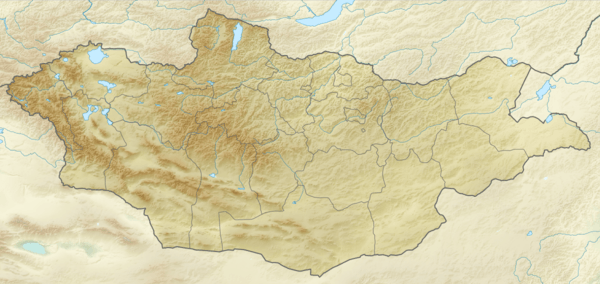Tsagaantsav Formation
The Tsagaantsav Formation, Tsagantsab Formation or Tsagan-Tsab Formation (Russian: Tsagaantsav Svita) is an Early Cretaceous (Hauterivian to Barremian) geologic formation in Mongolia.[1] Indeterminate sauropod and psittacosaurid remains have been recovered from the formation.[2] Remains of the pterosaur Noripterus, which were originally given their own genus, "Phobetor" have also been recovered from the formation.[3][4]
| Tsagaantsav Formation Stratigraphic range: Hauterivian-Barremian 131–126 Ma | |
|---|---|
| Type | Geological formation |
| Underlies | Zuunbayan Formation |
| Overlies | Basement |
| Lithology | |
| Primary | Sandstone, siltstone |
| Location | |
| Coordinates | 44.9°N 110.4°E |
| Approximate paleocoordinates | 46.7°N 112.3°E |
| Region | Khovd, Uvs, Dornogovi & Övörkhangai Provinces |
| Country | |
| Type section | |
| Named for | Tsagan-Tsab well |
 Tsagaantsav Formation (Mongolia) | |
Graham et al. 2001 reported radiometric dates of 131 and 126 Ma from the formation.[5]
Fossil content
The following fossils were reported from the fluvial to lacustrine sandstones and siltstones of the formation:[1]
- Pterosaurs
- Dinosaurs
- Lizards
- Dorsetisauridae indet.
- Insects
- Khutelchalcis gobiensis
- Eopelecinus fragilis
- E. minutus
- Praeichneumon townesi
- Eobraconus inopinatus
- Westratia femorata
- W. pachygaster
- W. pentadecamera
- Langtonius cynaricaudatus
- Eugenodiamesa makarchenkoi
- Jurochlus adustus
- Ellia khara
- Protanyderus mesozoicus
- Metatrichopteridium cladistorum
- Plectrocentropus sulis
- Eoclipsis mongolica
- Coptoclavisca nigricollinus
- Cretorabus orientalis
- Mesaclopus mongolicus
- Chinocimberis dispersus
- Megametrioxenoides longus
- Uroperla lacerata
- Trianguliperla quassa
- Aphaorus curtipes
- Juleyrodes ?gilli
- Izinabis kerzhneri
- Siberiogenites medius
- Torephemera longipes
- Leptoneta calyptrata
- Albisca tracheata
- Epeoromimus infractus
- Osmylogramma martinsoni[6]
- Juraphididae indet.
gollark: I don't want stupidly easy prefilled computers, I just don't want so much microcrafting.
gollark: ```osmarks:~/.multimc/instances/Generic Modpack/.minecraft# ls config/opencomputers/default.recipes gregtech.recipes hardmode.recipes peaceful.recipes settings.conf user.recipes```
gollark: Though openradio's not updated yet.
gollark: But yes, it is generally better.
gollark: Well, it looks as if I can't just conveniently set it to non-horrible recipes...
See also
- List of dinosaur-bearing rock formations
- List of pterosaur-bearing stratigraphic units
- Andaikhudag Formation
References
- Tsagaantsav Formation in the Paleobiology Database
- Weishampel et al., 2004, pp.517-607
- Barrett et al., 2008
- Lü et al., 2009
- Tsagan-Tsab well in the Paleobiology Database
- Ponomarenko, 1992
Bibliography
- Lü, J.; Y. Azuma; Z. Dong; R. Barsbold; Y. Kobayashi, and Y.-N. Lee. 2009. New material of dsungaripterid pterosaurs (Pterosauria: Pterodactyloidea) from western Mongolia and its palaeoecological implications. Geological Magazine 146. 690–700.
- Barrett, P.M.; R.J. Butler; N.P. Edwards, and A.R. Milner. 2008. Pterosaur distribution in time and space: an atlas in Flugsaurier: Pterosaur papers in honour of Peter Wellnhofer. Zitteliana B 28. 61–107.
- Weishampel, David B.; Peter Dodson, and Halszka Osmólska (eds.). 2004. The Dinosauria, 2nd edition, 1–880. Berkeley: University of California Press. Accessed 2019-02-21. ISBN 0-520-24209-2
- Ponomarenko, A.G. 1992. Novye setchatokrylye (Insecta: Neuroptera) iz mezozoya Mongolii. Novye Taksony Iskopaemykh Bespozvonochnykh Mongolii. Sovmestnaya Rossiisko-Mongol'skaya Paleontologicheskaya Ekspeditsiya 41. 101–111.
This article is issued from Wikipedia. The text is licensed under Creative Commons - Attribution - Sharealike. Additional terms may apply for the media files.